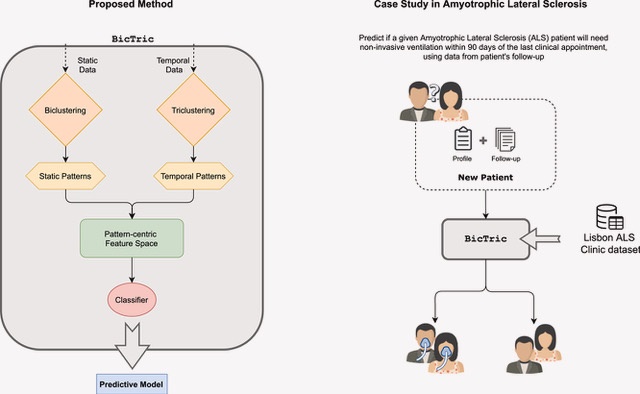The paper “Learning prognostic models using a mixture of biclustering and triclustering: Predicting the need for non-invasive ventilation in Amyotrophic Lateral Sclerosis”, authored by LASIGE’s PhD student Diogo F. Soares and Integrated Researcher Sara C. Madeira, has been published in the Journal of Biomedical Informatics a top-ranked journal in Computer Science Applications and Health Informatics (h5-index 63; Scimago Q1 in Computer Science Applications and Q1 in Health Informatics). The paper is co-authored by Rui Henriques (INESC-ID and Instituto Superior Técnico – Universidade de Lisboa), Marta Gromicho, and Mamede de Carvalho (Instituto de Medicina Molecular and Faculdade de Medicina – Universidade de Lisboa).
Longitudinal cohort studies to study disease progression generally combine temporal features produced under periodic assessments (clinical follow-up) with static features associated with single-time assessments, genetic, psychophysiological, and demographic profiles. Subspace clustering, including biclustering and triclustering stances, enables the discovery of local and discriminative patterns from such multidimensional cohort data. These patterns, highly interpretable, are relevant to identifying groups of patients with similar traits or progression patterns. Despite their potential, their use for improving predictive tasks in clinical domains remains unexplored.
In this work, we propose to learn predictive models from static and temporal data using discriminative patterns, obtained via biclustering and triclustering, as features within a state-of-the-art classifier, thus enhancing model interpretation. triCluster is extended to find time-contiguous triclusters in temporal data (temporal patterns) and a biclustering algorithm to discover coherent patterns in static data. The transformed data space, composed of bicluster and tricluster features, capture local and cross-variable associations with discriminative power, yielding unique statistical properties of interest.
As a case study, we applied our methodology to follow-up data from Portuguese patients with Amyotrophic Lateral Sclerosis (ALS) to predict the need for non-invasive ventilation (NIV) since the last appointment. The results showed that, in general, our methodology outperformed baseline results using the original features. Furthermore, the bicluster/tricluster-based patterns used by the classifier can be used by clinicians to understand the models by highlighting relevant prognostic patterns.
This work is the result of the research carried out in the framework of the EU-funded Brainteaser project. The paper is available here.
